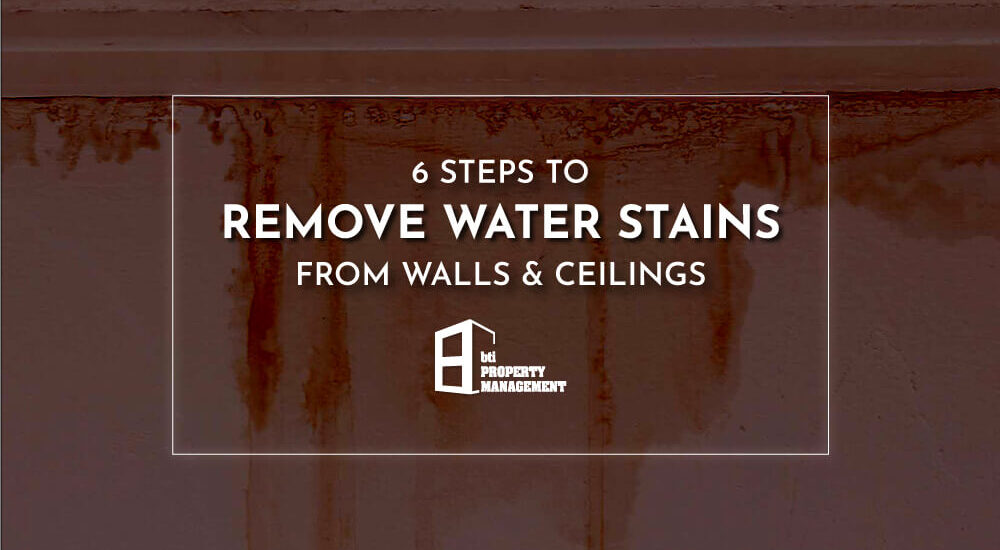- January 7, 2023
- Posted by: Humaira Urmi
- Category: Investment Decision

Plumbing leaks or flooding are especially upsetting when you’ve worked hard to give your home life by painting the walls and precisely decorating your space.
Water ruins walls and causes unsightly stains on your ceiling, ruining the appearance of your otherwise clean space. You might not need to paint your ceiling or replace the drywall to remove that water stain.
Why Are There Stains On My Walls & Ceilings?

Source: Homebuilding & renovating
Flood damage, pipe leaks, or other sources of moisture can all cause stains to form. Finding and fixing the water source is the first step in getting rid of this ugliness.
Otherwise, attempting to repair the surface without addressing the underlying problem would result in you having to keep mending the same spot.
You can begin removing the stain only after locating and fixing the leak.
Can you paint over the stain instead?

Source: Bob Vila
Water stains can be fixed by painting over them. However, this only works after the moisture source have been eliminated. This approach will, however, take more time and money than other, more effective approaches. if the source cannot be detected, there is no point in painting aimlessly. When experts identify the issue, ask them for internal and external paint services.
Finding something that matches the specific color and texture of the existing paint will be challenging if you have a different paint to match the ceiling. To have a persistent finish, you should paint the ceiling from top to bottom again.
6 Steps To Remove Water Stains From Walls & Ceilings

Source: remodelista
Do you want to get rid of those water stains within budget and a specific time frame? Then you have come to the right place! All you need is a spray bottle, bleach, and water.
These easy DIY steps can help:
Step 1:

Source: The Spruce
Bleach is a potent chemical that can harm your skin, lungs, and valuables. Consider taking some safety measures, like covering the room’s furniture and wall art, before combining and spraying the bleach solution. Wear safety gloves, a mask, and clothing you don’t mind getting bleach on.
Step 2:
Pour one part bleach and two parts tap water into a misting spray bottle.
Step 3:
Lightly spritz the stain with the solution, then let it a minute or so to dry.
Step 4:
Reapply the stain treatment and allow it to settle for up to 24 hours.
Step 5:
Repeat the procedure over several days if the stain is still obvious after the waiting period.
Step 6:
After cleaning, give the space 24 hours to air out before lounging there.
Will you have to paint the walls after bleaching?

Source: life’s dirty. Clean easy
After using bleach to treat the stain, there’s a strong possibility you will not need to repaint your white ceiling. But the bleach will make the paint lighter if your ceiling is cream, off-white, or any other hue.
If so, check in with paint experts. to see if there is any that you may use to cover the area that has been lightened. If not, you might have to repaint the ceiling completely.
When can’t you bleach to eliminate a water stain on the ceiling?
While using bleach to remove water stains usually works, there are few cases where bleach actually makes the stain worse. The chemical may further damage the materials if dampness has already caused the paint to peel or the drywall to disintegrate. You’ll need to fix the drywall in these situations and repaint it. Property Management experts can identify the source of dampness and fix the damage caused by it.
Remember…

Source: Square Feet Story
Water damage can seriously interfere with your plans for rest and relaxation, even when your living space has been refurbished and furnished to your heart’s delight. Along with any costs associated with fixing the moisture leak, your home now has unsightly stains that detract from its otherwise lovely appearance.
Try this quick and simple technique to save your ceiling and your time and money before finishing a comprehensive makeover of your wall or ceiling. If DIY is not your thing, get in touch with professionals who deal with dampness and paint issues.
